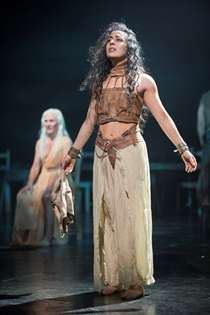|
Back
A New Take on Opera’s Favorite Psychopath Washington
Lansburgh Theatre
10/06/2015 - & October 7, 8, 9, 10, 11, 12, 14, 15, 16, 17, 18, 19, 21, 22, 23, 24, 25, 26, 28*, 29, 30, 31, November 1, 2, 4, 5, 6, 7, 8, 2015
Yaël Farber: Salomé
Nadine Malouf (Salomé), Olwen Fouéré (Nameless Woman), Ramzi Choukair (Iokanaan), T. Ryder Smith (Pontius Pilate), Lubana Al Quntar (Singer), Yuval Boim (Caiaphas), Jeff Hayenga (Annas), Tamar Ilana (Singer), Shahar Isaac (Bar Giora), Ismael Kanater (Herod), Richard Saudek (Yeshua the Madman), Elan Zafir (Abaddon)
Yaël Farber (director), Ami Shulman (movement), Susan Hilferty (sets and costumes), Donald Holder (lights), Mark Bennett (music and sound)

N. Malouf (© Scott Suchman)
Washington’s venerable Shakespeare Theatre Company has opened its season with this originally commissioned multimedia piece treating one of the world’s great femmes fatales, the lustful and murderous Salomé. A radical adaptation of Oscar Wilde’s play and Richard Strauss’s close operatic treatment, feminist director Yaël Farber seeks to turn the original concept from a "Dance of Death" into a "Dance of Life." Her major challenge to the audience is to find female political agency in the sexualized themes of the Biblical story. Rather than a sex-obsessed tart warped by the perversion surrounding her at Herod’s court, Farber’s Salome is endowed with a rebellious spirit. She is a fundamentally political entity energized to bold action at a time when religious transformation threatened the underpinnings of the existing order. The intention is to capture the voice of feminine agency in this process, a process Farber assumes to have been written out of history via its male-voiced cultural depictions.
Farber has built something of a career out of this sort of thing. Her internationally recognized adaptation of Strindberg’s Miss Julie relocated the play from class-conscious nineteenth-century Sweden to race-conscious post-apartheid South Africa. Another original work, called Nirbhaya, also embraced themes of sexual violence and went on to win several awards at the Edinburgh Festival.
There clearly are some grounds for such an approach. Salome’s "problem" is never adequately explained by Wilde or Strauss, or by other creators (e.g. Flaubert, Massenet, Gustave Moreau) who approached her troubled persona through artistic media. Why is she so obsessed with Iokanaan? Why does she desire his death? What is the source of her obvious emotional trauma? While these might be the right questions, however, Farber does little more than her predecessors to address them. If the others (all men) "mansplain" Salome in an arguably inaccurate way, then Farber’s original take merely "womansplains" her. And the only way she can do this is to change the story in almost all of its details. Salome is thus not extinguished but rather lives on in a disembodied female voice, a spooky older character identified only as "Nameless Woman." The latter’s monologues connect Salome’s murder of Iokanaan with a broader female rejection of masculine authority. Unconvincingly, this is supposed to presage the Hebrew revolt of 66-70 AD, decades after the time of the action. To be sure this was a heroic act, but it resulted in total defeat by the Romans, the destruction of the Temple of Solomon, and the exile of Hebrews from their homeland. It seems odd that this historical cataclysm could be seen as a positive result of feminine empowerment, but no further explanation is ventured. Nor do we get a much clearer picture of Salome’s obsession with Iokanaan. Here she provocatively enters his cistern rather than order his removal from it for her inspection. But again, reinterpreting the original sources to redefine Salome goes nowhere. The great questions remain unanswered, and the political problem would seem to have no solution.
Farber’s effort does at least bring us somewhat into the milieu of the Salome myth, and evocative staging imparts a degree of unnerving power. Susan Hilferty’s costumes could be taken from any 1950s Hollywood warehouse and her sets are mostly basic, but it was clever to have the characters circulate around the stage on a moving belt in statue-like poses. Are they actors of are they acted upon? Adding musical chant to the production’s spoken parts gave a powerful sense of the fanaticism surrounding the characters and their motivations.
Farber also assembled a talented young cast. As Salome, the sultry Nadine Malouf neatly treaded the balance between innocence and mania that the character needs to emerge in relief. Fine though it was, I wondered whether this mannered approach to the femme fatale or femme fragile tropes really answered the demands of modern feminism. Olwen Fouéré evocatively voiced the lines of Salome’s older, disembodied self. The French-Syrian performer Ramzi Choukair delivered a muscular performance as Iokanaan and intriguingly declaimed much of his part in Arabic, hinting that the current antagonisms of the Middle East may have their roots in the political difficulties of antiquity.
The Shakespeare Theatre commissioned the work as its entry in the capital’s Women’s Voices Theater Festival, an event involving some 50 regional theaters. But I left the theater wondering what this inventive if rather bizarre work really adds to our understanding of gender in contemporary society and if it succeeds in telling us more than we would have learned from a thoughtful interrogation of the original sources.
Paul du Quenoy
|